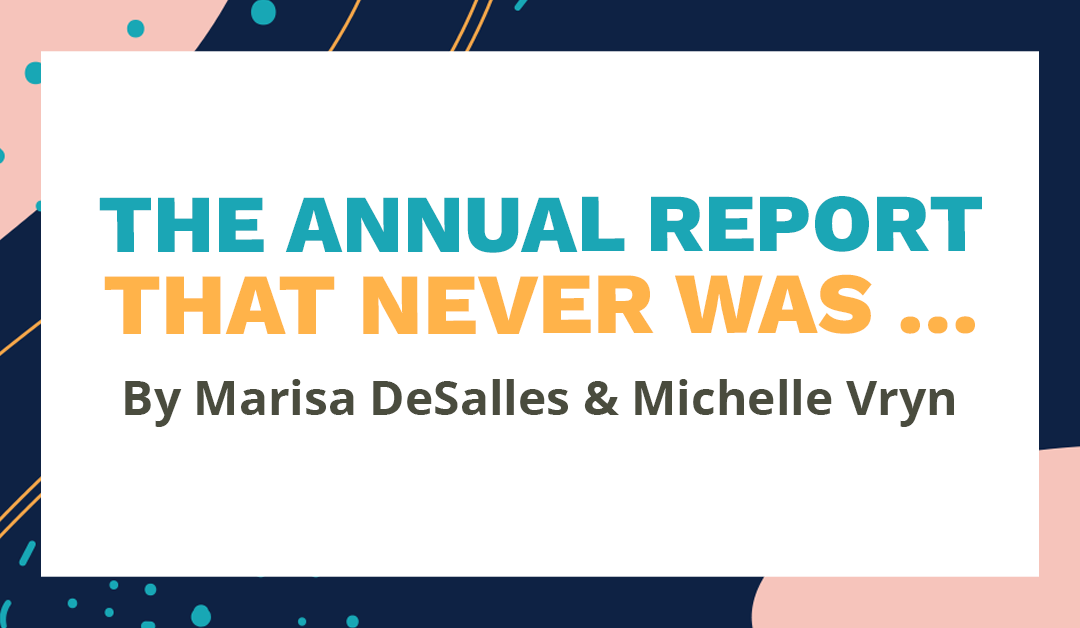A collaboration between Marisa DeSalles and Michelle Flores Vryn

These graphs are pretty, but meaningless — just like most of the data we tend to present in our annual reports.
As DEI professionals will tell you, one way to assess the authenticity of your workplace culture is to take stock of the types of messaging that circulate around the office. Are they overwhelmingly positive? (“We received this grant!” “Enrollment goals were exceeded!” “We can make payroll!”)
Seriously though, consider whether you are perpetuating a tone of toxic positivity. If you are, it likely flows over into your external messaging. Like your annual report.
Go us! Look at what we’ve done!
We’re good at touting our accomplishments as nonprofits. We write annual reports as our centerstage statement of impact. Typically, this caters to our donors, reinforcing their feelings of being good people, thus increasing the chances they’ll fund us again. It’s a self-fulfilling cycle. Or at least we hope it is.

Photo by Alexander from Pexels.
“This stock image doesn’t represent our workforce at all, but we hope it will make us appeal to millennial donors of color”
Here are questions we often ignore though:
What do annual reports communicate about us, in terms of what we do not say? What if we wrote them honestly, for and with the community instead?
If we’re being honest …
Recall your last annual report — now, imagine it if it were honest. Like, this-couples-therapy-is-our-last-desperate-shot-before-divorce honest.
Do your donors (big and small), funders (local and national), staff (entry level and c-suite), and volunteers (board members and program supporters) actually know what your day-to-day reality is? Do they know the infrastructure needs that you lack? What about your actual holistic need?
Or is it just about which of their initiatives or personal priorities you currently happen to fit into?
Do they not know these facts because you are distorting reality?
Let’s be more real about the challenges we’re up against, including our gap in service each year. I mean, we never fully accomplish our potential for impact, do we? Many times, that is understandable — after all, we’re tackling the world’s most complex and deeply rooted injustices — but that should not prevent us from being real about our service gap and resource need.
Being more honest will help all players in the social impact ecosystem be better equipped to build high-impact relationships, select joint priorities, and collaborate effectively.
Annual reports are too often like posts on Instagram, where content is highly curated and the beauty filter is liberally applied to faces and to lifestyles. Let’s get a little more authentic.
What does this toxic positivity conceal? Who’s excluded?
By only highlighting what we have accomplished and neglecting to discuss the gap of service that we have yet to fill, we are painting an incomplete picture. Worse, by misrepresenting our reality, we are excluding our strongest supporters from the opportunity to direct more resources to where we really need them.
Here’s an example:
A nonprofit organization we know suffered during the pandemic, like many other nonprofits. This particular one dealt with the sudden loss of their charismatic founder. Their infrastructure was woefully inadequate for online programming. They lacked reliable internet, and their office was a windowless cloakroom in a hundred-year-old building with mice and a broken elevator. They hired and lost their first full-time ED in mere months.
However, at their recent board retreat, they were also able to identify the gaps in service and infrastructure as well as honestly explored their own lived experiences and connections to the mission. They realized that one of their core programs was effectively serving as a pipeline of talent for their team of volunteer support group facilitators — a pipeline that could be more efficiently utilized.
They had also recently won a big grant and were in a position to win more funding for their work.
So, which of those stories are they going to tell this year in their annual report?
Conventional wisdom might say they should highlight the grant, make the most of the programs they were still able to deliver, and maybe only briefly mention the leadership transition.
Or, they could write about the full picture. They could include a photo of their current dismal little office, They could openly discuss the challenges of finding the perfect leader during a pandemic. They could end with an appeal to the community for help in finding new offices and a new ED.
Remove the rose-colored glasses, then articulate funding the full picture
Annual reports are tweaked to highlight the positive statistics. But stating the full need should not make us, as nonprofits, feel ‘less than’ or inadequate. On our shoulders we carry the psychological impact of trying to heal the wounds of society. It’s a lot. And we cannot do it all. Nor should we have to.
The wider community, including donors, need this full picture to understand their place in the cycle of social impact. It is our responsibility, as nonprofits, to tell an authentic story of need — this includes what’s lacking to fulfill our mission.
The ugly truth about our staff
Imagine if your staff update read something like this:
“We’re happy to report we’ve opened up our offices again amidst a rise in Delta variant cases. Absolutely none of our staff surveyed want to be working in the office full time, but our board president felt it was more important to have ‘coverage’ of a physical space no one is visiting, in spite of the fact that phone numbers can be forwarded. Besides, we thought it would be unfair if we allowed workplace flexibility to those who came to depend on it for childcare and eldercare this past year.
“We’ve made great progress on our DEI efforts. Our frontline staff, all underpaid and mostly people of color, created a beautifully detailed work plan for improvements. We promptly gaslit all their experiences and hired an expensive consultant to evaluate our salary structure instead of just giving them raises.
“Also, in an unrelated matter, we’re hiring for sixteen staff positions.”
Okay, maybe that was too honest. Now, obviously we might not want to shine a light on our staffing struggles. We fear it may make us appear unsustainable. But maybe that’s the real problem — maybe our workplace practices are unsustainable. As a sector, our crappy, antiquated hiring practices (#showthesalary) and workplace conditions came under a harsh and unforgiving light this past year.
Many nonprofit pros, especially women and people of color, are moving away from the sector for entrepreneurship or leaving the job market entirely. They are disillusioned by the gap between high ideals and harsh workplace realities, and tired of juggling the demands of family along with work. Younger folks are discovering that nonprofits are painfully slow to keep up with the changing demands of a workforce facing life-altering, global challenges, and looking elsewhere.
The Great Resignation is well underway. Nonprofit employers, wake up. It’s not unemployment benefits that are keeping people out of the job market. It’s a realization: We deserve better and there are employers who will give it to us.
Being more honest about your struggles could actually help you attract and retain better staff. Also, give them a raise, a bottle of their favorite beverage, a hug, and an extra week of PTO while you’re at it.
A better way forward
This is a time for us as nonprofit leaders to speak honestly about our needs, about our successes and about our crushing defeats. This is a time for radical honesty.
January 1st is an opportunity to toss out your existing template and go through this thought exercise. Deeply review your organization’s messaging and evaluate its honesty and transparency. At your team meeting, ask:
- Why are we doing this — who is this report for?
- Can we see our authentic selves in this write-up?
- What areas are we more opaque about (hint: overhead) and what impact would it have if we highlighted these areas?
- Is this the right template to show our work? Are we thinking critically about the kind of metrics that are most meaningful to us (such as measuring donor love)?
- Are the voices of our community truly represented? Are the stories that we are telling, being told ethically?
- Are the right voices in the decision making space?
- What is the gap of service that has not been filled, and why has it not been filled?
- How can the reader engage in solving the gap?
If we were to start from scratch, the annual report should really be a co-creation between the nonprofit and community served. You might be in a position to do just that — but we recognize that change is more often incremental and nonprofit progress is slow. Maybe your annual report template was carved in stone by the board president’s great-uncle and painted in the blood of your revered founder, may she rest in peace.
But you can still get creative and find a way to include marginalized voices and stories, even if not in this communication. Consider creating an adjunct report that is co-authored by the community you serve, that articulates their vision of your services. Maybe you put forth a new space on your website or a separate social account solely for community-generated stories, like a participatory video series.
Our supporters deserve honesty. Let’s uncheck the filter button and show the moles, pores and wrinkles. We believe readers will not be turned away, but lean more deeply into our mission.
Authors’ note: Portions of this article were inspired by anonymous contributors who shared their personal stories of working in nonprofits. To them, we are eternally grateful.

Marisa DeSalles & Michelle Flores Vryn
Marisa DeSalles (she/her) is spending her quarantime growing zucchini bats on her front lawn, obsessing over other people’s Zoom rooms, and actively spoiling a multi-generational and multi-species household. Her favorite superhero is Word Girl and she is overly fond of commas, especially the Oxford one. Please subscribe to her new blog at marisadesalles.com so she can justify renovating her she-shed. Politics on Twitter, critters and plants on Insta @kidscatzntech. You can send Marisa a tip via her Venmo, @marisa-desalles.
Michelle Flores Vryn, CFRE (she/her/ella) has worked in almost every area of development: institutional giving, major gifts, membership, capital campaigns, consulting, special events, and annual giving. She has a healthy obsession for equitable social impact and currently serves on the Association of Fundraising Professionals (AFP) Global’s Marketing, Awards & Communications Committee. Michelle lives in Austin, Texas and is always down for spontaneous outdoor adventures and dropping in on live music. She is a two-time graduate of the Hispanic Serving Institution (HSI) The University of Texas at San Antonio. Find her on LinkedIn to keep the CCF convos going! You can send Michelle a tip via her Venmo, @Michelle-Flores-Vryn.
Discover more from CCF
Subscribe to get the latest posts sent to your email.



Thank you for writing this! We just sent out our year-end appeal. While we did share some of the internal struggles we’ve faced in moving toward collective governance, it didn’t come close to portraying accurately the challenges we’ve faced (and the tears we’ve shed!). A good reminder to be more truthful, more honest, and braver in sharing our stories with donors and supporters. Appreciate both of your concrete suggestions at the end, too.
This is a super insightful article — thanks for putting it out there!
Loved it! Annual repots really do need to be started over. Agreed we have to start sharing with our donors the ups and downs. They need to know their help makes a difference. Come January, I am going to look at ht questions again and come up with an attempt at doing something different. Now i the perfect time.
This is brilliant. I love everything about this article and all the issues highlighted for consideration. Thank you Michelle and Marisa for writing such a well thought out article with a good bit of levity.
This was great. Thank you so much for encouraging us to ditch the toxic positivity. It is draining. I just like plain old positivity surrounded by some really real realness. Love reading CCF stuff!